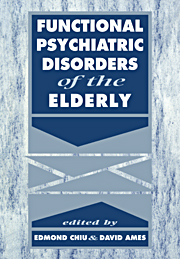Book contents
- Frontmatter
- Contents
- List of contributors
- Preface
- Introduction – A personal note
- Acknowledgement
- Part 1 Classification
- Part 2 General epidemiology
- Part 3 Neuroses
- Part 4 Affective disorders
- 7 The epidemiology of affective disorders in old age
- 8 The outcome of depressive illness in old age
- 9 Pseudodementia in geriatric depression
- 10 Depression in nursing and residential homes
- 11 Depression in primary care settings
- 12 Treatment of depression in the elderly
- 13 Mania in late life: conceptual and clinical issues
- 14 Suicide in the elderly
- Part 5 Psychosexual disorders
- Part 6 Substance use and abuse
- Part 7 Schizophrenia and related psychoses
- Part 8 Psychological, biological and medical issues
- Part 9 Treatment methods
- Part 10 Conclusion
- Index
8 - The outcome of depressive illness in old age
from Part 4 - Affective disorders
Published online by Cambridge University Press: 13 November 2009
- Frontmatter
- Contents
- List of contributors
- Preface
- Introduction – A personal note
- Acknowledgement
- Part 1 Classification
- Part 2 General epidemiology
- Part 3 Neuroses
- Part 4 Affective disorders
- 7 The epidemiology of affective disorders in old age
- 8 The outcome of depressive illness in old age
- 9 Pseudodementia in geriatric depression
- 10 Depression in nursing and residential homes
- 11 Depression in primary care settings
- 12 Treatment of depression in the elderly
- 13 Mania in late life: conceptual and clinical issues
- 14 Suicide in the elderly
- Part 5 Psychosexual disorders
- Part 6 Substance use and abuse
- Part 7 Schizophrenia and related psychoses
- Part 8 Psychological, biological and medical issues
- Part 9 Treatment methods
- Part 10 Conclusion
- Index
Summary
Historical
There is strong evidence that, in antiquity, physicians were well aware of senile depression as a condition apart from dotage (Post, 1986). In the eighteenth century, even nonmedical writers were conversant with recoverable senile depressions. In the nineteenth century, however, the flourishing of brain pathology generated the widespread belief that depressions occurring for the first time during old age were early indicators of cerebral deterioration and precursors of dementia. Post (1951) and Roth & Morrissey (1952) were the first to distinguish the comparatively hopeful outcome of depressed patients from the outcome of those suffering from organic disorders.
Landmark studies of the outcome of depressive illness in the elderly are the six-year follow-up study of Post (1962) and the later three-year follow-up by the same author (Post, 1972). He studied two cohorts of depressed elderly inpatients treated by himself: the first in 1950 when electroconvulsive treatment (ECT) and leucotomy were the only effective physical treatments available, and the second in the 1960s when tricyclic antidepressants had been added. He concluded that there had been no improvement in prognosis despite the advances in treatment. The disappointing result in the second cohort may, however, have been due to a larger number of socially disadvantaged patients in that series as well as the inclusion of patients who had failed to respond to pharmacotherapy (not available in 1950) prescribed by their family doctors or in the outpatient department (Post, 1986).
- Type
- Chapter
- Information
- Functional Psychiatric Disorders of the Elderly , pp. 111 - 125Publisher: Cambridge University PressPrint publication year: 1994
- 1
- Cited by

